Introduction to Modern UI Website Design
![]()
In today’s fast-paced digital world, simply having a website is not enough; what matters is the quality of user experience and its visual appeal.
This is where the concept of #modern_UI_website_design comes into play.
A modern user interface (UI), beyond mere aesthetics, focuses on #user_interaction with the site, #ease_of_use, and quick #responsiveness.
The main goal in designing a website with an advanced user interface is to create a seamless bridge between information and the user, which not only meets their needs but also provides a pleasant and memorable experience.
In this explanatory chapter, we examine why this approach has become a necessity in the current era.
The competitive market, changing user tastes, and technological advancements all necessitate that businesses move towards modern UI website design.
This design style not only helps attract more audience but also significantly increases the conversion rate.
Today’s users have high expectations for websites; they seek speed, simplicity, beauty, and usability on any device.
Ignoring these principles can mean losing customers and falling behind competitors.
Therefore, investing in a website with a modern UI is a strategic decision for the future of any online business.
This approach ensures that your site always remains fresh, efficient, and attractive.
Tired of losing customers due to poor e-commerce website design? With Rasavab, solve this problem forever!
✅ Increase sales and visitor-to-customer conversion rates
✅ Smooth and engaging user experience for your customers⚡ Get free consultation
Key Principles in User-Friendly UI Design

To achieve a truly user-friendly modern UI website design, adhering to several key principles is essential.
The first principle is simplicity.
A complex user interface confuses and tires the user, causing them to leave your site.
Simplicity means removing unnecessary elements and focusing on the most important information and functionalities of the site.
The second principle is consistency.
Visual elements, fonts, colors, and button placement should be uniform across all pages of the site to prevent user confusion.
This consistency significantly contributes to a smooth and predictable user experience.
Appropriate feedback is the third and crucial principle; users should receive a response from the system after every action they perform, for example, by changing the color of a button or displaying a confirmation message.
This feedback assures the user that their action has been successfully completed.
Accessibility is also very important; modern UI website design should be usable by all users, including those with disabilities.
This includes appropriate color contrast, adjustable font sizes, and keyboard navigation options.
Finally, visual hierarchy plays an important role; by using size, color, and negative space, more important elements should be highlighted to naturally guide the user’s gaze towards them.
Following these educational principles and guidelines helps you build a site that is not only beautiful but also truly efficient and enjoyable for users.
This approach is the foundation of any advanced UI website design.
Psychology of Color and Font in Modern Web Design
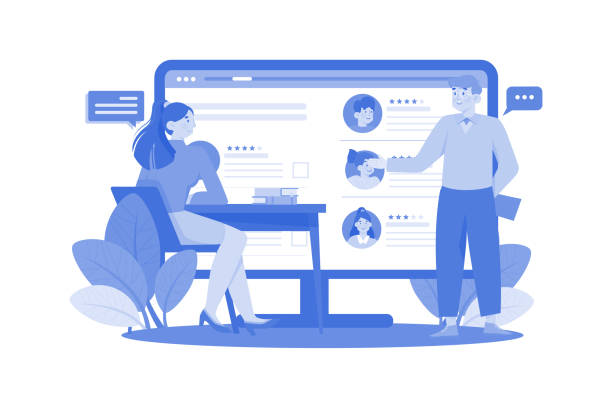
In the art of modern UI website design, colors and fonts are not merely aesthetic elements; they are powerful tools for communicating with the audience and influencing user psychology.
Choosing the right color can evoke specific emotions, convey a particular message, and even influence user behavior.
For instance, blue often conveys a sense of trust and professionalism, while red can evoke passion, excitement, or warning.
This specialized aspect of design requires a deep understanding of the cultural and psychological effects of colors.
Alongside colors, fonts also play a crucial role in advanced UI website design.
A readable and appropriate font improves the user experience and effectively conveys the content’s message.
Font selection should align with the brand’s identity and the site’s purpose.
Serif fonts typically convey a traditional and authoritative feel, while sans-serif fonts appear more modern and friendly.
The correct combination of colors and fonts can give your website personality and appeal.
Below is an educational table of the effects of some common colors in UI design:
| Color | Common Emotions or Meanings | Typical UI Application |
|---|---|---|
| Blue | Trust, Calmness, Reliability, Professionalism | Technology, Finance, Health, Call to Action Buttons |
| Green | Nature, Growth, Freshness, Security, Health | Environment, Health, Finance (Success), Confirmation Buttons |
| Red | Passion, Energy, Urgency, Warning, Love | Sales, Food, Warnings, Delete or Danger Buttons |
| Yellow | Happiness, Energy, Optimism, Creativity | Education, Children, Warning (with Black) |
| Orange | Warmth, Excitement, Enthusiasm, Creativity | Art, Entertainment, Secondary Buttons, Special Calls to Action |
| Black | Sophistication, Power, Luxury, Formality | Fashion, Luxury, Minimalist Design, Background |
| White | Purity, Simplicity, Cleanliness, Modernity | Negative Space, Main Background, Minimalist Design |
These specialized elements, when chosen carefully and intelligently, add more depth and impact to your modern UI website design.
User Experience (UX) Beyond Visual Beauty

In the discussion of modern UI website design, the question of the difference between UI and UX often arises. While UI (User Interface) deals with the appearance and feel of a digital product (how it looks), UX (User Experience) deals with how the user interacts with it (how it feels).
User Experience is a broader concept that encompasses all aspects of the end-user’s interaction with the company, its services, and its products.
A website with a modern UI is only successful if its UX foundations are strong.
This means a deep understanding of users’ needs, behaviors, and pain points.
UX research includes user interviews, persona creation, user journey mapping, and usability testing.
The results of this research guide the modern UI website design team to create interfaces that are not only beautiful but also effectively solve user problems and help them achieve their goals.
For example, designing a beautiful registration form (UI) is good, but if this form is too long or contains irrelevant questions, it provides a poor user experience (UX).
The importance of UX is that it increases customer loyalty and helps business growth.
A strong UX leads to increased customer satisfaction, reduced bounce rate, and increased conversion rates.
Therefore, understanding this distinction and emphasizing UX research and testing before any UI activity is a critical analytical step towards designing an advanced and functional UI website.
Without strong UX, even the best UI cannot guarantee the long-term success of a website.
This perspective is the cornerstone of modern web design.
Are you worried your old company website might scare away new customers? Rasavab solves this problem with modern and efficient corporate website design.
✅ Increases your brand’s credibility.
✅ Helps attract targeted customers.
⚡ Contact Rasavab for a free consultation!
New Tools and Techniques in UI Development

To implement an efficient and modern UI website design, designers and developers require a set of advanced tools and techniques.
In the design sphere, software like Figma, Sketch, and Adobe XD have become industry standards.
These tools enable wireframe design, creation of interactive prototypes, and live team collaboration, which significantly speeds up the design process and increases its efficiency.
Features such as Component Libraries in these tools greatly help maintain consistency and stability in design.
In development, the use of modern JavaScript frameworks like React, Vue.js, and Angular has become a standard.
These frameworks allow for the creation of complex and dynamic user interfaces with a component-based approach.
This means that UI elements are designed and coded as independent, reusable blocks, leading to faster development, cleaner code, and easier maintenance.
Furthermore, version control tools like Git and platforms such as GitHub or GitLab are essential for team collaboration and tracking code changes.
Techniques like Atomic Design also help designers create scalable and modular design systems, which provide a robust foundation for any modern UI website design.
These specialized tools and guiding techniques allow teams to more efficiently and with higher quality create websites with advanced UI that are excellent in both aesthetics and functionality.
Challenges and Solutions for Responsive and Compatible Design
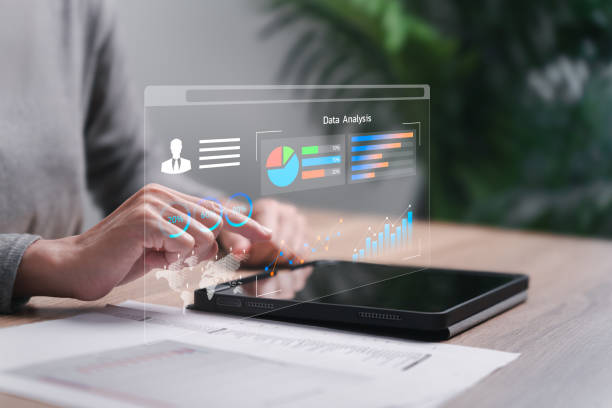
One of the biggest challenges in modern UI website design is ensuring its responsiveness and compatibility with various devices and screen sizes.
Given the countless varieties of smartphones, tablets, and monitors, creating a consistent and optimal user experience across all platforms can be complex.
The question is, how can one ensure that a website not only looks good on a desktop but also maintains its functionality and beauty on the smallest mobile screens? The Mobile-First approach is one of the most effective solutions.
In this approach, design begins for the smallest screen and then gradually expands for larger devices.
This ensures that the most important content and functionalities are prioritized, and the site is fast and efficient on mobile devices.
The use of CSS Grid and Flexbox are also powerful tools for creating flexible and responsive layouts that allow designers to easily adjust page elements across different sizes.
Optimizing images and using next-generation image formats (like WebP) to reduce file sizes and increase loading speed on mobile is also crucial.
Furthermore, rigorous testing on various devices and emulators is necessary to identify and resolve compatibility issues.
These challenges require a guided and continuous approach in modern UI website design to ensure that your website provides the best possible experience for every user, on every device.
This aspect of modern web design is the foundation of accessibility and inclusivity.
Exploring Current and Future Trends in Web User Interface

The world of modern UI website design is constantly evolving and innovating.
With technological advancements and changing user expectations, new trends emerge that elevate the user experience to a new level.
One of the trending and popular news is Dark Mode, which not only helps reduce eye strain but also gives websites a chic and modern look.
Micro-interactions, small details such as visual feedback when clicking a button or subtle animations during scrolling, also play a significant role in increasing user enjoyment and engagement.
These small details can make a big difference in the user’s overall feeling.
3D Design and the use of complex animations make websites more dynamic and entertaining, but should be used cautiously to avoid harming site loading speed.
The future of modern UI website design is also moving towards Artificial Intelligence (AI) and Augmented Reality (AR).
AI-powered UI systems can personalize the user experience based on user behavior and create more interactive and intelligent user interfaces.
Augmented Reality can also provide new possibilities for content interaction, especially in areas like e-commerce.
These analytical developments show that innovative UI design is becoming smarter and more interactive every day.
Below is a comparative table between traditional and modern approaches in UI design:
| Feature | Traditional UI Design | Modern UI Design |
|---|---|---|
| Main Focus | Basic appearance and functionality | Comprehensive User Experience (UX) and visual aesthetics |
| Responsiveness | Often non-responsive, desktop-specific | Fully responsive, compatible with all devices (mobile-first) | User Interaction | Simple and static | Dynamic, including micro-interactions and animations |
| Color and Font | Limited choice, without deep psychology | Precise selection based on color and font psychology |
| Optimization | Often less attention to loading speed | Performance optimization for high speed |
| Design Philosophy | Function over form | Form and function (form and function in parallel) |
| Design Tools | Photoshop, simple HTML/CSS | Figma, Sketch, Adobe XD, modern JS frameworks |
These trends represent the future of modern web design and guide us towards smarter and more inclusive user interfaces.
Security and Sustainability in Modern UI Website Design
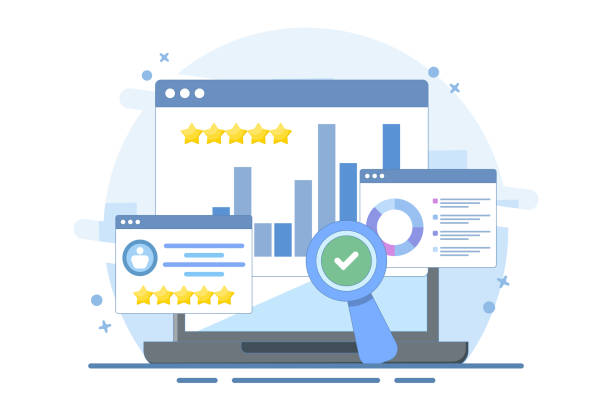
Alongside beauty and efficiency, security and sustainability are two fundamental pillars in modern UI website design.
An advanced UI website, no matter how beautiful and user-friendly, will quickly lose user trust if it is vulnerable to security threats.
Ensuring security across various layers, from server-side coding to client-side interactions, is essential.
This includes using secure protocols like HTTPS, rigorous validation of user inputs to prevent XSS and SQL Injection attacks, and keeping libraries and frameworks up-to-date.
From a user interface perspective, secure UI design means transparently informing the user about security status, for example, displaying error or success messages related to sensitive operations, and designing forms that securely collect sensitive information.
In addition to security, maintainability is also a crucial specialized factor.
A website must be designed and coded in such a way that it can be easily updated, maintained, and developed in the future.
This includes using clean and modular code, proper documentation, and adherence to coding standards.
In modern UI website design, using design systems and reusable components not only accelerates the development process but also ensures the site’s long-term sustainability and stability.
Ignoring security and maintainability can lead to significant future costs, data loss, and damage to brand reputation.
Therefore, every decision in modern web design must be made with these two vital elements in mind, so that an advanced UI website remains successful and trustworthy not only now but also in the future.
Are you bothered by losing customers who visited your site to make a purchase?
Rasavab is your specialized solution for a successful online store.
✅ Significantly increase your online sales
✅ Build trust and professional branding with customers⚡ Get free consultation from Rasavab experts!
Measuring Success and Optimizing User Interface
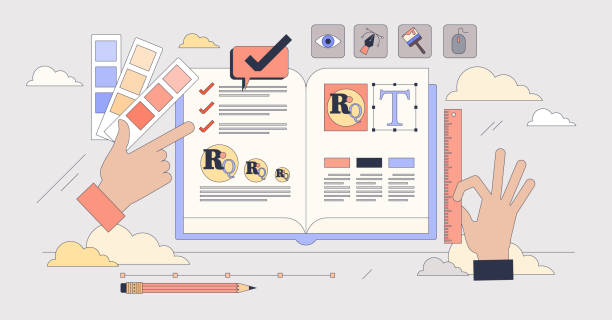
After implementing a modern UI website design, the next crucial step is measuring its success and continuous optimization.
A good website is never a finished product; rather, it is an ongoing process of improvement and adaptation to user needs.
Analytical tools like Google Analytics and Heatmap tools like Hotjar provide valuable insights into user behavior.
Metrics such as Conversion Rate, Bounce Rate, Time on Page, and Click Paths can indicate the strengths and weaknesses of your UI.
For example, a high bounce rate on a specific page might indicate a problem in that page’s UI design, which frustrates users and causes them to leave the site.
A/B testing is one of the most powerful educational methods for UI optimization.
In this method, two different versions of a UI element (e.g., the color of a button or the title of a section) are randomly shown to different users, and the performance of each version is compared based on predefined metrics (such as click-through rate).
This process helps you make design decisions based on real data, not just guesswork.
In addition to quantitative data, direct user feedback through surveys, interviews, and focus groups is also highly valuable.
These qualitative feedbacks can provide deep insights into user problems and expectations that might not be discoverable through quantitative data.
By combining these guiding methods, an advanced UI website can be continuously optimized, ensuring that your modern web design is always improving.
Conclusion and Next Steps for a Brilliant Website
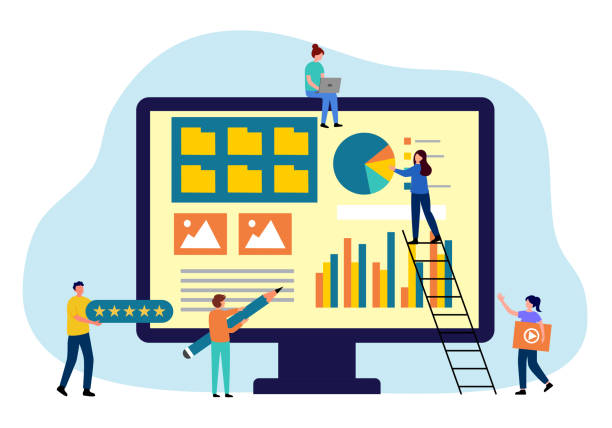
Throughout this article, we have explored various dimensions of modern UI website design; from fundamental principles and color psychology to advanced tools and the challenges of responsiveness.
We learned that an innovative user interface, beyond mere aesthetics, pays special attention to user experience, security, and future scalability.
The most important conclusion is that modern UI website design is a vital investment for any business or individual seeking success in the digital space.
This approach not only helps attract more audience but also increases customer loyalty and ultimately leads to business growth and development.
What are your next steps? First, evaluate your current site with a fresh perspective.
Is its user interface truly modern and user-friendly? Are the principles of simplicity, consistency, and appropriate feedback observed?
Then, based on your needs and goals, create a structured plan for redesigning or optimizing your site’s user interface.
Do not forget that close collaboration among UI designers, developers, and UX specialists is essential to achieve the best results.
The digital market is changing every day, so dynamism and readiness to embrace new trends in modern web design are the keys to your success.
By focusing on these principles and using new tools, you can create an advanced UI website that not only meets today’s needs but is also ready for future challenges.
Let your website not only have excellent content but also, with a brilliant modern UI website design, create an unforgettable experience for its visitors.
Frequently Asked Questions
| Question | Answer |
|---|---|
| What is modern UI website design? | It’s an approach to website design that focuses on clean aesthetics, simplicity, high usability, and delivering a visually appealing and pleasant user experience (UX). |
| What are the key elements of a modern web UI? | Flat Design, smart use of white space, engaging typography, intuitive navigation, high-quality images, and responsiveness are key elements. |
| Why is using a modern UI important in website design? | It attracts and retains users, increases brand credibility, improves conversion rates, and provides a smooth and pleasant user experience. |
| How does modern User Interface (UI) affect User Experience (UX)? | Modern UI directly improves the user experience by creating a beautiful, organized, and understandable environment, making interaction easier. |
| What is the role of typography in modern UI design? | Typography is crucial for readability, creating information hierarchy, conveying brand mood, and the overall visual appeal of the site. |
| How does Responsive Design relate to modern UI? | Responsive design is an integral part of modern UI, as it ensures that the site’s appearance and functionality are consistent and optimal across all devices (mobile, tablet, desktop). |
| What are the current trends in modern web UI design? | Dark Mode, subtle animations, creative use of white space, prominent typography, and asymmetric graphic elements are among recent trends. |
| How can one ensure a modern UI has high Usability? | By conducting user testing, simplifying navigation, providing clear Calls to Action (CTAs), improving loading speed, and focusing on Accessibility. |
| What is the main difference between UI and UX in modern design? | UI is the look and feel of the site (user interface), while UX is the overall experience of the user when interacting with the site. UI is considered a part of UX. |
| What tools are used for modern web UI design? | Common tools like Figma, Sketch, Adobe XD, Photoshop, and Illustrator are used for designing and prototyping modern user interfaces. |
And other advertising services from Rasa Web Advertising Agency:
- Smart Link Building: A creative platform to improve customer acquisition by optimizing key pages.
- Smart Customer Journey Map: A fast and efficient solution to improve SEO ranking by focusing on Google Ads management.
- Smart Advertising Campaign: Professional optimization for user engagement using precise audience targeting.
- Smart Digital Branding: A combination of creativity and technology to increase sales through personalized user experience.
- Smart Sales Automation: A creative platform to improve campaign management with marketing automation.
And more than hundreds of other services in the field of internet advertising, advertising consulting, and organizational solutions.
Internet Advertising | Advertising Strategy | Advertorials
Resources
The Importance of Modern UI/UX in Website Design
The Impact of Website Design on Digital Success
Principles of Responsive Website Design
Web Design Trends in the Current Year
? For your business to shine in the digital world, from personal website design to comprehensive marketing campaigns, Rasavab Digital Marketing Agency offers creative and results-driven solutions.
📍 Tehran, Mirdamad Street, next to Bank Markazi, Kazeroun Jonoubi Alley, Ramin Alley, No. 6

